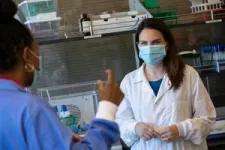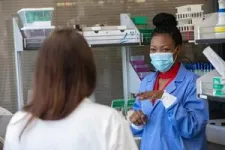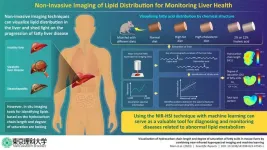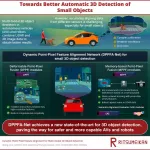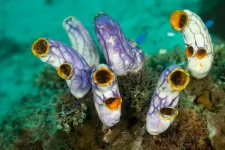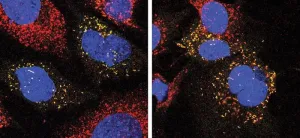(Press-News.org) BINGHAMTON, N.Y. -- Researchers from Binghamton University, State University of New York are unraveling the workings of Group B Strep (GBS) infections in pregnant women, which could someday lead to a vaccine.
One in five pregnant women carry Streptococcus agalactiae (Group B Strep or GBS) in the vaginal tract, which is typically harmless — except when it isn’t.
The bacterial infection poses serious and even fatal consequences for newborns, including pneumonia, sepsis and meningitis, which can have long-term effects on the child’s cognitive function.
Researchers from Binghamton University’s Biofilm Research Center and the School of Pharmacy and Pharmaceutical Sciences (SOPPS) are unraveling the workings of GBS infections, which could someday lead to a vaccine. Their article, “In silico and experimental analysis of the repeated domains in BvaP, a protein important for GBS vaginal colonization,” was recently published in Infection and Immunity.
“This research has identified and characterized a novel protein that could serve as a vaccine candidate to fight a bacterium that impacts women’s reproductive health and neonatal outcomes,” said first author Lamar Thomas PhD ’23, now a postdoctoral fellow at the University of California, San Diego, in the Department of Pediatrics. “I hope this work will inspire others to explore other novel proteins and microbial agents that may potentially aid in improving global health.”
When most people think of “strep,” they have in mind Streptococcus pyogenes — Group A Strep or GAS, which causes strep throat and necrotizing fasciitis, a “flesh-eating” infection, explained Assistant Professor of Biological Sciences Laura Cook, a co-author of the paper along with Nicholas Faiola of the Biofilm Research Center and Emily Canessa and Yetrib Hathout of SOPPS.
“There are many other pathogenic species of Streptococcus as well, including GBS and Streptococcus pneumoniae, which also causes many diseases, especially in the elderly,” she said.
GBS can pass from mother to child in utero, potentially causing preterm birth, or after birth via close contact like breastfeeding, but these infections are rare. Most commonly, the infection is transmitted from mother to child during the birthing process, likely due to the aspiration of contaminated bodily fluids. Because of the risks, pregnant women in the United States are tested during their last trimester and treated with antibiotics if they are found to be positive. While antibiotics have decreased the rates of neonatal GBS disease in developed countries, the World Health Organization has placed a high priority on developing a vaccine.
To successfully colonize, the bacteria create a biofilm that allows them to stick to each other and the human host. Key to that biofilm is a protein known as BvaP, which Cook’s lab established in previously published research.
Blocking surface proteins such as BvaP could be key to developing a successful vaccine, protecting newborns from infection. Cook’s lab is now looking at the regulation of this protein, how this affects its function and how it may interact with other GBS proteins and the host.
“Even if BvaP does not prove to be a viable vaccine candidate, the process of host colonization is essential to understand for developing treatment strategies against bacterial pathogens,” Cook said.
END
Protecting newborns: Research lays the groundwork for a lifesaving vaccine
Transmitted through the birth process, the bacteria Streptococcus agalactiae can have potentially lethal consequences
2024-01-09
ELSE PRESS RELEASES FROM THIS DATE:
New study unveils machine learning-aided non-invasive imaging for rapid liver fat visualization
2024-01-09
Steatotic liver disease (SLD), previously known as non-alcoholic fatty liver disease, which includes a range of conditions caused by fat build-up in the liver due to abnormal lipid metabolism, affects about 25% of the population worldwide, making it the most common liver disorder. Often referred to as “silent liver disease,” SLD progresses without noticeable symptoms and can lead to more severe conditions like cirrhosis (liver scarring) and liver cancer.
A liver biopsy—an invasive procedure involving liver tissue sample extraction from the body—is ...
Towards more accurate 3D object detection for robots and self-driving cars
2024-01-09
Robotics and autonomous vehicles are among the most rapidly growing domains in the technological landscape, with the potential to make work and transportation safer and more efficient. Since both robots and self-driving cars need to accurately perceive their surroundings, 3D object detection methods are an active area of study. Most 3D object detection methods employ LiDAR sensors to create 3D point clouds of their environment. Simply put, LiDAR sensors use laser beams to rapidly scan and measure the ...
How fruit bats got a sweet tooth without sour health
2024-01-09
Levi Gadye, 628-399-1046
Levi.Gadye@ucsf.edu | @UCSF
Video: https://ucsf.app.box.com/s/i3atd54ye4m1z1spi0qf59axq7tq7640
Subscribe to UCSF News
A high-sugar diet is bad news for humans, leading to diabetes, obesity and even cancer. Yet fruit bats survive and even thrive by eating up to twice their body weight in sugary fruit every day.
Now, UC San Francisco scientists have discovered how fruit bats may have evolved to consume so much sugar, with potential implications for the 37 million Americans with diabetes. The findings, published on Tuesday, Jan. 9, 2024 in Nature Communications, point to adaptations ...
Vaccine demonstrates potential in delaying relapse of KRAS-mutated pancreatic and colorectal cancers
2024-01-09
HOUSTON ― A vaccine showed potential to prevent relapse of KRAS-mutated pancreatic and colorectal cancers for patients who had previously undergone surgery, according to a Phase I trial led by researchers at The University of Texas MD Anderson Cancer Center. Results were published today in Nature Medicine.
In the trial, patients with pancreatic and colorectal cancer who were considered at high risk of relapse received a maximum of 10 doses of the ELI-002 vaccine targeted toward KRAS G12D and G12R mutations. T cell responses were seen in 84% of all patients and in 100% of those in the two highest dose cohorts, including those who ...
Smart skin bacteria are able to secrete and produce molecules to treat acne
2024-01-09
International research led by the Translational Synthetic Biology Laboratory of the Department of Medicine and Life Sciences (MELIS) at Pompeu Fabra University has succeeded in efficiently engineering Cutibacterium acnes -a type of skin bacterium- to produce and secrete a therapeutic molecule suitable for treating acne symptoms. The engineered bacterium has been validated in skin cell lines and its delivery has been validated in mice. This finding opens the door to broadening the way for engineering non-tractable bacteria to address skin alterations and other diseases using living therapeutics.
The research team is completed by scientists from the Bellvitge Biomedical Research ...
Stranger than friction: A force initiating life
2024-01-09
As the potter works the spinning wheel, the friction between their hands and the soft clay helps them shape it into all kinds of forms and creations. In a fascinating parallel, sea squirt oocytes (immature egg cells) harness friction within various compartments in their interior to undergo developmental changes after conception. A study from the Heisenberg group at the Institute of Science and Technology Austria (ISTA), published in Nature Physics, now describes how this works.
The sea is full of fascinating life forms. From algae and colorful fish to marine snails and sea squirts, a completely different world reveals itself underwater. Sea squirts or ascidians in particular are very unusual: ...
Different biological variants discovered in Alzheimer's disease
2024-01-09
Dutch scientists have discovered five biological variants of Alzheimer's disease, which may require different treatment. As a result, previously tested drugs may incorrectly appear to be ineffective or only minimally effective. This is the conclusion of researcher Betty Tijms and colleagues from Alzheimer Center Amsterdam, Amsterdam UMC and Maastricht University. The research results will be published on 9 January in Nature Aging.
In those with Alzheimer's disease, the amyloid and tau protein clump in the brain. In addition to these clumps, other biological processes such as inflammation and nerve ...
Alzheimer Europe adopts position on anti-amyloid therapies for Alzheimer’s disease, issuing a call to action for timely, safe and equitable access
2024-01-09
Luxembourg, 9 January 2024 – In a new position paper, and following engagement with its national members and the European Working Group of People with Dementia (EWGPWD), Alzheimer Europe calls for concrete actions to enable timely, safe and equitable access to anti-amyloid drugs, for patients who are most likely to benefit from these innovative new treatments for Alzheimer’s disease (AD).
The growing prevalence and impact of AD has catalysed huge investments in research on its causes, diagnosis, treatment and care. After many high-profile ...
Improved cellular recycling could benefit patients with neurodegenerative conditions
2024-01-09
For the first time, a research team at The Hospital for Sick Children (SickKids) has uncovered a way to potentially reduce the amount of toxic cellular waste accumulating in patients with Zellweger Spectrum Disorder (ZSD).
ZSD is a group of rare, neurodegenerative genetic conditions caused by genetic variations that reduce the number of peroxisomes – the parts of cells that are responsible for, among other tasks, breaking down fats. ZSD varies in severity and is characterized by progressive neurodegeneration as well as symptoms that range from visual impairments, such as cataracts, to liver and kidney disfunction.
Like all living ...
Green ammonia could decarbonize 60% of global shipping when offered at just 10 regional fuel ports
2024-01-09
A study published today in IOP Publishing’s journal Environmental Research: Infrastructure and Sustainability has found that green ammonia could be used to fulfil the fuel demands of over 60% of global shipping by targeting just the top 10 regional fuel ports. Researchers at the University of Oxford looked at the production costs of ammonia which are similar to very low sulphur fuels, and concluded that the fuel could be a viable option to help decarbonise international shipping by 2050.
Around USD 2 trillion will be needed to transition to a green ammonia fuel supply chain by 2050, primarily to finance ...
LAST 30 PRESS RELEASES:
Review article | Towards a Global Ground-Based Earth Observatory (GGBEO): Leveraging existing systems and networks
Penn and UMich create world’s smallest programmable, autonomous robots
Cleveland researchers launch first major study to address ‘hidden performance killer’ in athletes
To connect across politics, try saying what you oppose
Modulating key interaction prevents virus from entering cells
Project explores barriers to NHS career progression facing international medical graduates
Jeonbuk National University researchers explore the impact of different seasonings on the flavor perception of Doenjang soup
Two Keck Medicine of USC Hospitals named Leapfrog Top Teaching Hospitals
World-first discovery uncovers how glioblastoma tumours dodge chemotherapy, potentially opening the door to new treatments
A fatal mix-up: How certain gut bacteria drive multiple sclerosis
New AI tool identifies not just genetic mutations, but the diseases they may cause
Deep-learning model predicts how fruit flies form, cell by cell
Combination pills for high blood pressure may simplify treatment, improve long-term health
Immune system keeps mucosal fungi in check
Neurons within the brain use simple rules to localize genetic messages
Electrodes created using light
Second-hand gift-giving is a well-deliberated decision
How human interaction drove evolution to make bears less aggressive
National Poll: Few parents offer teens guidance on healthy eating during holiday season
Cannabis derivatives could provide new ovarian cancer treatments
Raising strong yeast as a petroleum substitute
Clues to the origin of hot Jupiters hidden in their orbits
Canada’s reduced pledge to Global Fund will impact domestic health
1 in 4 children with major traumatic injuries not cared for in pediatric trauma centres
Duke and Duke-NUS’ joint cross-population research to uncover "East-West" differences in disease and care
Scientists to ‘spy’ on cancer- immune cell interactions using quantum technology breakthrough
Tech savvy users have most digital concerns
Making lighter work of calculating fluid and heat flow
Normalizing blood sugar can halve heart attack risk
Lowering blood sugar cuts heart attack risk in people with prediabetes
[Press-News.org] Protecting newborns: Research lays the groundwork for a lifesaving vaccineTransmitted through the birth process, the bacteria Streptococcus agalactiae can have potentially lethal consequences

